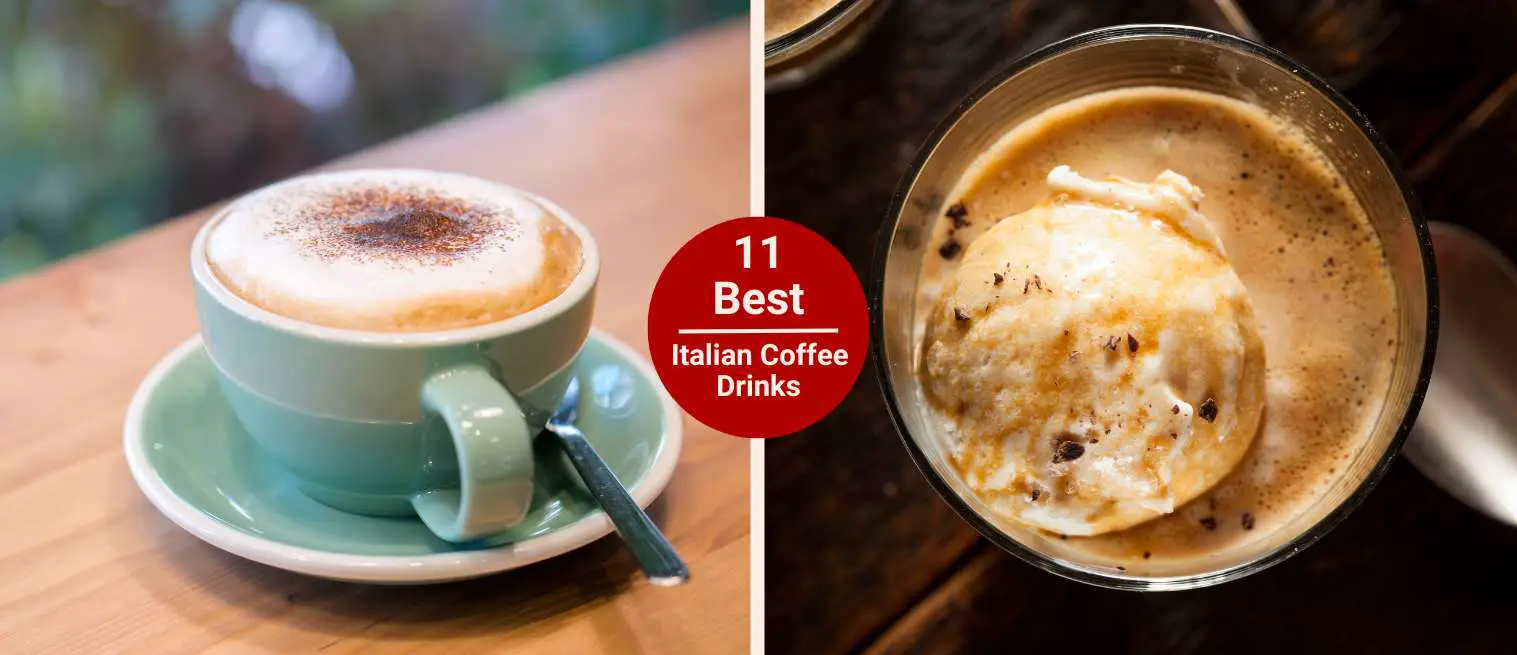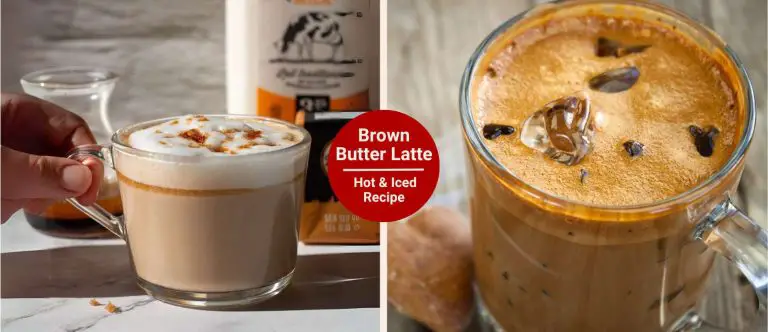11 Best Italian Coffee Drinks You Must Try
Last updated on June 25th, 2025 at 02:34 pm
Ever wondered what makes Italian coffee culture so unique?
Before I started Coffee Voilà, I used to sip on cappuccinos and lattes without thinking twice. Just whatever looked good on the café menu.
But then I fell down the espresso rabbit hole and started learning about how Italians actually take their coffee.
The fact is every drink has its own time, place, and personality. I was ordering a latte in Rome once and got a plain glass of milk.
Lesson learned: there’s a whole coffee language I hadn’t even started speaking yet.
In this guide, you’ll get to know 11 of the most iconic Italian coffee drinks. From quick, bold shots at the bar to creamy, dessert-like sips you’ll want to linger over. And who knows? You might just find a new favorite coffee that changes your whole routine.
11 Best Italian Coffee Drinks
From bold espresso shots to sweet, creamy drinks, these classic Italian coffee drinks show how much flavor and tradition can fit in a cup.
Anyway, if you’re curious about what Portugal’s brewing? Don’t miss my list of the 11 Best Portuguese Coffee Drinks too. You might find your next favorite there!
1 – Espresso (Caffè)
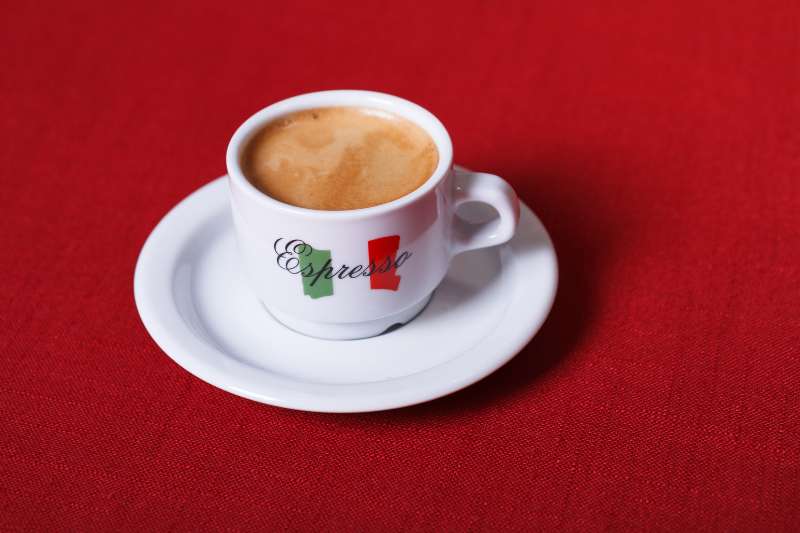
Espresso, or just caffè as locals call it, is the heart of Italian coffee culture. It’s short, strong, and served in a tiny porcelain cup, usually with no milk.
People often drink espresso fast. You order it at the bar, sip it in two or three gulps (standing, of course), and you’re out the door.
A standard shot is about 25–30ml of coffee, brewed under high pressure for around 25 seconds. What you get is an intense, concentrated flavor with a thick crema on top.
If you’re feeling brave (or just sleepy), try a ristretto, which is a shorter shot with less water.
On the flip side, there’s the doppio (a double espresso) if one isn’t enough. Personally, I like starting the day with a single and saving the doppio when I feel really sleepy.
Pro tip: skip the sugar the first time. Just taste the espresso. Let it hit your tongue, and see what you think. Some blends are naturally sweet or fruity, others more nutty or bitter.
2 – Cappuccino
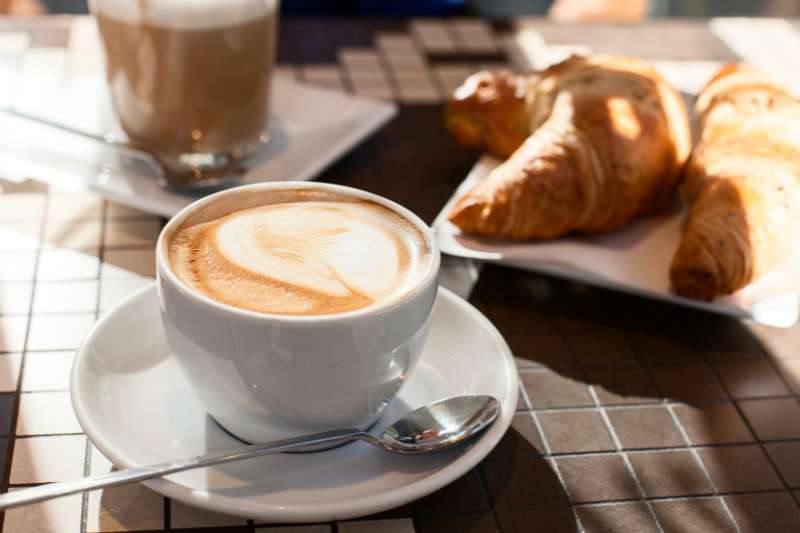
Probably one of the most misunderstood Italian coffee drinks by tourists. I remember the first time I ordered one in the afternoon in a local , and the barista gave me that look.
Not rude or anything, but just a quiet “Ah, a foreigner” kind of smile. That’s when I learned: in Italy, cappuccino is strictly a breakfast drink.
Because locals believe the milk is too heavy for later in the day, especially after a meal. The drink itself is beautifully balanced.
A classic ratio is 1:1:1. This means one part espresso, one part steamed milk, and one part foamed milk. It’s not a latte (which has way more milk) and it’s not espresso with a splash of froth either.
A good cappuccino should be smooth, creamy, and still let that espresso punch through.
If you want to enjoy it like a local, grab a cornetto (basically the Italian cousin of the croissant, often filled with jam or custard). Dunking it into the cappuccino? Totally acceptable. Honestly, it’s one of the best simple breakfasts I’ve ever had.
Quick tip: don’t ask for cinnamon or chocolate powder on top unless you’re in a tourist-heavy spot. Most Italian cafés don’t do that. Just the foam, plain and perfect.
3 – Caffè Macchiato
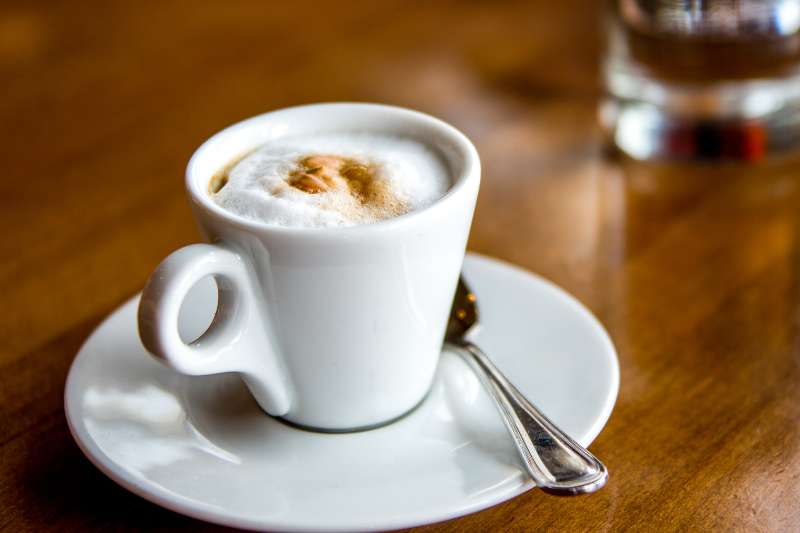
It’s essentially a shot of espresso “stained” (that’s what macchiato means) with just a touch of foamed milk, maybe half a spoonful or a full one.
There’s no strict ratio, honestly. The idea here is that you still get that bold, rich espresso kick, but with just a hint of softness from the milk foam.
It takes the edge off without messing with the intensity, which is great if you’re easing into Italian coffee culture. But not quite ready to drink straight espresso shots all day.
I enjoy either brewing at home or ordering one mid-morning, especially if I’ve already had a cappuccino earlier.
It’s quick, cheap, and gives you just enough caffeine to keep going without the weight of a latte or cappuccino. Also, don’t confuse it with the Starbucks-style macchiato. That’s a whole different thing.
Notes: Italian coffee culture is all about keeping it simple and letting the espresso shine through.
4 – Caffè Latte
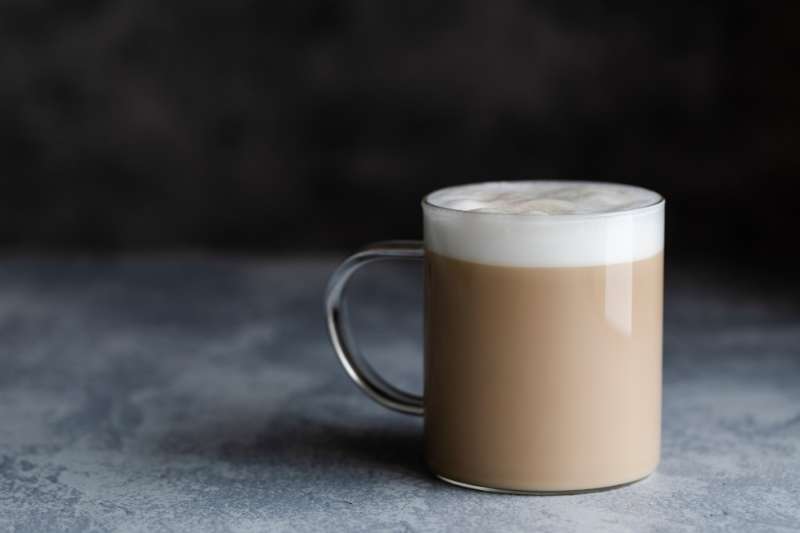
If you grew up on milky coffee, this one’s your comfort zone. The caffè latte is essentially what Italians make at home when they’re not rushing out the door.
It’s more mellow and way milkier than a cappuccino. I remember messing up the ratio the first time I tried making one: too much espresso, not enough milk, and it tasted like a bitter soup.
What you want is something like 1 part espresso to 3 or even 4 parts steamed milk. Also, skip the heavy foam like you’d find in a cappuccino. Instead, aim for smooth, silky milk.
One simple trick: warm your glass or mug first so the drink stays hot longer and doesn’t cool down too quickly.
Most Italians won’t order a caffè latte at a bar. It’s kind of seen as a homemade breakfast drink. And heads-up, if you go to an Italian café and ask for a “latte,” you’ll get just milk. No coffee.
That’s because in Italy, ‘latte’ literally means milk, plain and simple.
Note: I suggest pairing your homemade latte with a chunk of crusty bread or a biscotti on the side. It’s perfect for slow and easy mornings.
5 – Caffè Corretto

“Corretto” means “corrected,” and in this case, you’re correcting your espresso with a shot of liquor.
You can also use grappa if you want that classic Italian burn, sambuca for a sweeter, anise-like note, or brandy if you’re feeling fancy. Most bars use a 1:4 ratio. So, about 10ml of liquor for every 40ml espresso.
However, most people often eyeball it. Some even pour the shot on the side, letting you “correct” it to your taste.
This one hits different. It’s not about sipping slowly; it’s bold, boozy, and warms you up from the inside out.
Usually, it’s great for long winter nights or after a heavy meal when you still want caffeine but also a bit of a kick.
Oh, and don’t forget to give your cup a little swirl before the last sip. It helps everything settle right, and that final swig is where the magic hides.
6 – Caffè Shakerato
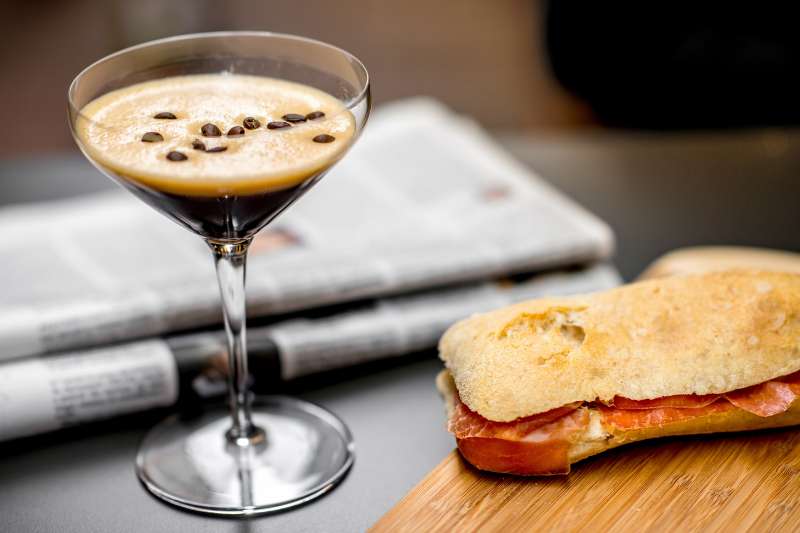
A caffè shakerato is Italy’s answer to iced coffee. You start with a fresh shot of espresso (about 30ml), mix in one to two teaspoons of sugar while it’s still hot, and then shake it vigorously with ice in a cocktail shaker.
After about 15–20 seconds of hard shaking, the result is a frothy, chilled espresso poured into a stemmed glass.
What makes it different from tossing ice into coffee is that shaking aerates the drink, giving it that creamy foam on top without milk.
The sugar helps stabilize the foam and adds a subtle sweetness. If you want to tweak it, try brown sugar for deeper notes or even a splash of vanilla.
Notes: It’s the perfect warm-weather drink. Just remember: no milk, no extras, and definitely no straw. I suggest sipping it slowly and enjoying that contrast between the bold espresso and the silky chill.
7 – Marocchino

Marocchino is this beautiful combo of espresso, cocoa, and creamy milk foam layered in a tiny glass.
Here’s the basic idea: it starts with a shot of strong and rich espresso. Then, dust some unsweetened cocoa powder; don’t skip this part, as it’s what gives it that slightly bitter chocolate bite.
Afterward, top it with foamed milk. You only want enough to give it a light and airy texture. Some cafés add a sprinkle of cocoa on top again for good measure, and you should steal that move.
Now, don’t go drowning this thing in milk. It’s not a mocha or a cappuccino. You want the espresso to still take the lead, with the chocolate and foam giving it a creamy twist.
I prefer having it mid-afternoon. Usually when I’m starting to feel a bit tired but not quite ready for a full meal.
Notes: It pairs well with a biscotti or even a square of dark chocolate if you’re going all in. I suggest serving it in a small glass too. It makes the whole thing feel a bit more special.
8 – Affogato al Caffè

Basically, Affogato is dessert and caffeine in a single scoop-and-pour experience. All you do is take one generous scoop of gelato, traditionally vanilla, and pour a fresh shot of hot espresso right over it. T
The contrast between hot and cold, bitter and sweet, makes it all the more delicious.
I like to use a double shot of espresso when I want that kick. Just make sure your gelato is firm and your espresso is hot.
And serve it in a small glass or bowl, something clear if you can, because watching the gelato slowly melt into the coffee is half the experience.
Now, while vanilla is the classic base, don’t be afraid to get creative. I’ve tried it with hazelnut gelato and salted caramel ice cream. Both worked well.
Hazelnut adds a nutty richness, and salted caramel gives you that sweet-salty contrast that’s ridiculously good.
Notes: No need to stir it. Just dig in with a spoon and maybe take a sip from the side.
9 – Caffè Freddo

Okay, if you’ve never had caffè freddo, let me tell you it’s like Italy’s answer to iced coffee, but done their way.
The ratio is pretty straightforward: one shot of espresso, sweetened while hot (sugar dissolves better that way), then shaken or chilled over ice until cold.
Some bars actually keep it in a bottle in the fridge, pre-made and ready to pour. Others will shake it up fresh for you like a cocktail. Personally, I like my shaked because it adds a bit of froth on top.
Pro tip: If you’re making it at home, brew your espresso strong and don’t skip the sugar. This helps balance the bitterness when it’s cold. Let it cool slightly before adding ice so it doesn’t get watered down.
Also, serve it in a small glass. It’s not meant to be a big drink; it’s quick, bold, and refreshing. You’ll find it perfect for those summer afternoons when you need a caffeine kick without the heat.
10 – Caffè Ginseng
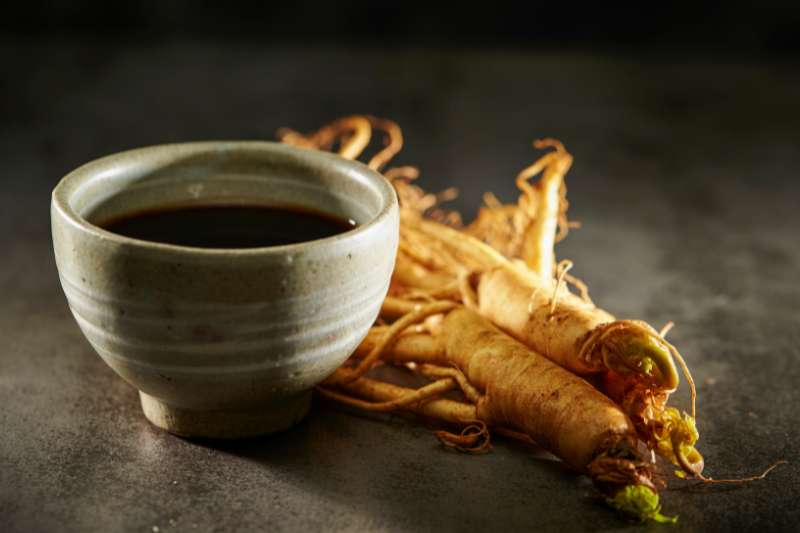
I first stumbled on caffè ginseng by total accident. One day, I was reading about the health benefits of herbs online and came across an article in Whole Foods Magazine that mentioned it.
I figured I’d grab a quick espresso, but then I saw “Caffè Ginseng” on the menu. I was curious (and slightly skeptical), but I hit the button anyway. And it was creamy, sweet, and had this nutty-earthy taste I couldn’t quite place, but I liked it.
Caffè ginseng is a mix of instant espresso, powdered milk, sugar, and ginseng extract. Usually, it’s creamier and sweeter than your regular shot, which makes it feel more like a dessert-coffee hybrid.
That smooth flavor also means it’s great if you want something energizing but don’t love bitter drinks.
If you want to make it at home, here’s the usual ratio: about 2 teaspoons of ginseng coffee mix to 100ml of hot water.
Some people like it stronger, more like 3 teaspoons to the same amount of water. However, that depends on your taste.
Afterward, stir well until it’s frothy on top. You can also use steamed milk instead of water for a thicker, latte-style version.
11 – Caffè d’Orzo
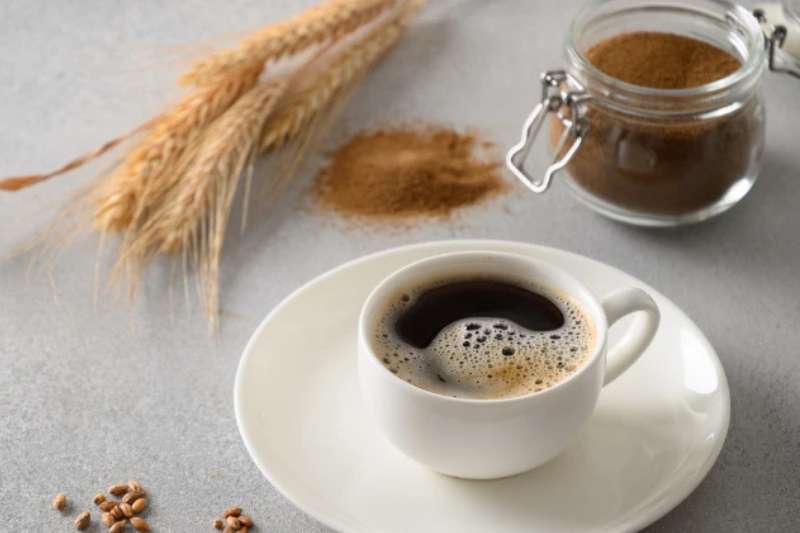
Caffè d’orzo is a popular caffeine-free alternative in Italy, especially for people cutting back or for kids who want to feel grown-up ordering from the bar.
The taste is more nutty and mellow, kind of like a cross between coffee and toasted cereal. It’s not sweet, but it doesn’t bite either, which makes it easy to drink even without sugar.
At home, you can make it with an orzo capsule, moka pot, or even a French press, depending on what you’ve got.
If you’re doing it the traditional way, try about 1 heaping teaspoon of orzo powder for every 100ml of water. That’s close to the standard single espresso shot. If you like it stronger, just go 1.5 teaspoons.
Pro tip: treat it like a real espresso. I recommend serving it in a small cup and perhaps adding a splash of milk or foam on top. It won’t replace your morning brew. However, for afternoons or caffeine-free days? It totally works.
Last Thoughts
And there you have it. Some of Italy’s most iconic (and a few underrated) coffee drinks. Each one has its own flavor and its own moment, and honestly, they’re all worth trying at least once.
Have you tried any of these before? I’d love to hear which one’s your favorite or if you have a go-to tip or another Italian drink I didn’t mention. Just leave a comment below and with that… voilà!

